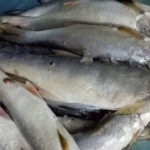Brackish water fish are not only a nutritious food source for various delicious dishes, but they also contribute to the economic conditions of some fishing and farming households. Join us as we explore the common brackish water fish that homemakers should know about.
1 What is Brackish Water?
Brackish water can be considered a mix of seawater and freshwater, and this type of water usually occurs at river mouths, mangrove forests, brackish fossil water layers, or is man-made, such as waste from salinity gradient energy technology activities or coastal flooding that forms brackish water ponds for shrimp farming.
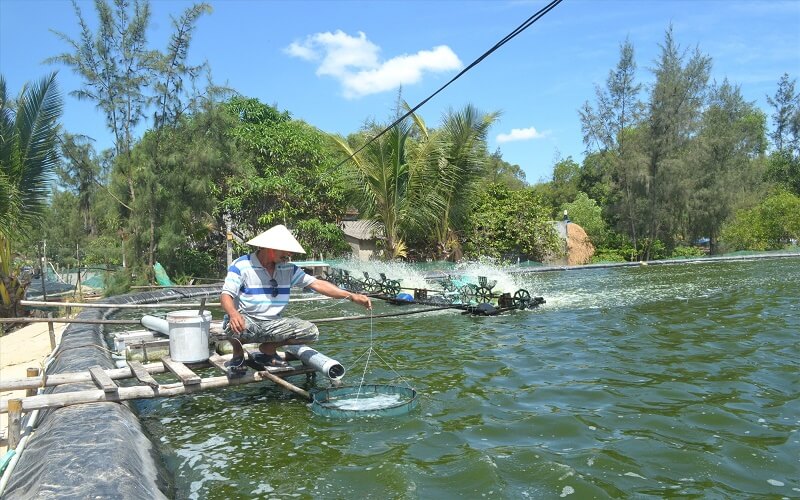 Brackish water is a mix of seawater and freshwater.
Brackish water is a mix of seawater and freshwater.
Although it can be used for shrimp and fish farming, most brackish water is not suitable for the development of flora and fauna and, therefore, needs to be managed and controlled to prevent selfish activities that create brackish water, which can negatively impact the ecological environment.
2 Common Types of Brackish Water Fish
While brackish water has few animals or plants, some fish species can adapt and thrive in brackish water ponds, including:
Giant Trevally
A familiar species to those who enjoy hot pot and often appears on wedding menus. Giant trevally, with the scientific name Rachycentron canadum, has an average lifespan of up to 15 years and a distribution mainly in tropical seas, the western and eastern Atlantic, the Pacific, and the Caribbean.
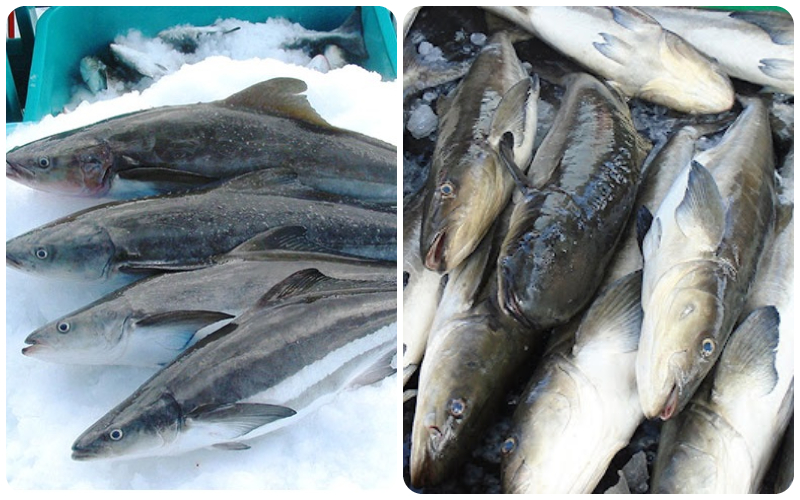 Giant trevally, with the scientific name Rachycentron canadum.
Giant trevally, with the scientific name Rachycentron canadum.
This fish has a slender body, a large head, sharp teeth, thick skin and fat, small scales, and long fins from the back to the tail. In Vietnam, giant trevally can be found in muddy and sandy areas of the intertidal zone, feeding on siliceous algae and other plankton.
Barramundi
Also known as sea bass, with the scientific name Lates calcarifer, this species can survive in freshwater, seawater, and brackish water. With an average length of 19-25 cm, barramundi has a gray body, a white silver belly, a connected and dominant dorsal fin, a large and pointed head, and a round protruding tail fin.
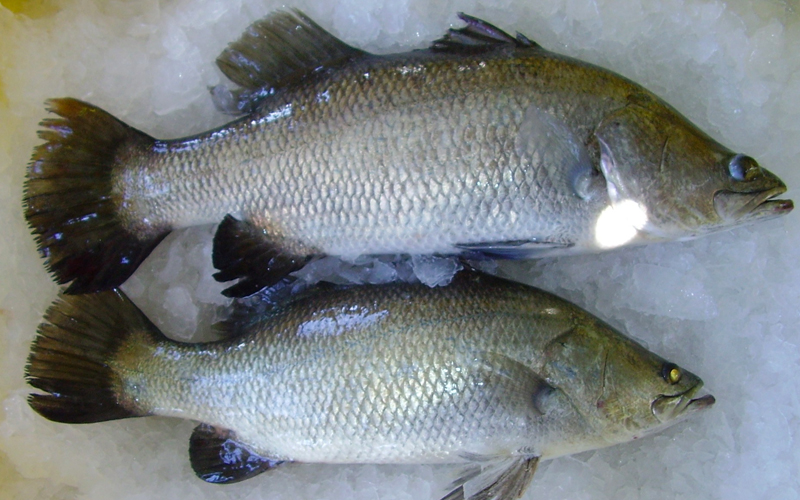 Barramundi, or sea bass, with the scientific name Lates calcarifer.
Barramundi, or sea bass, with the scientific name Lates calcarifer.
This species adapts to both marine and freshwater environments, and its characteristics vary depending on its habitat. In marine environments, the barramundi’s back is brown, while its belly and sides are silver. In freshwater, the belly and sides are yellowish-brown.
Grouper
Also called coral trout, this species is mainly distributed from the Gulf of Tonkin to the Gulf of Thailand, with a higher concentration in the provinces of South Central Vietnam, typically inhabiting depths of about 10-30 meters, a pH of 7.5-8.3, and temperatures between 25-32 degrees Celsius.
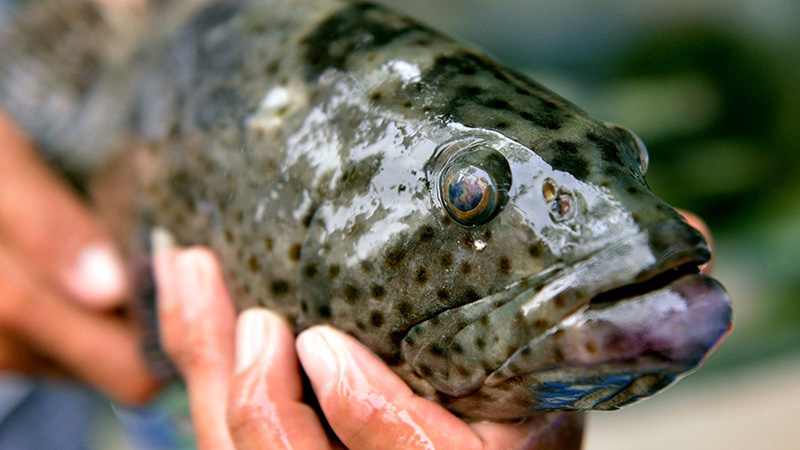 Grouper, also known as coral trout.
Grouper, also known as coral trout.
Regarding size, groupers can reach lengths of 10-270 cm, with a smooth, thick, and elongated body, a large mouth, and a long dorsal fin in the shape of a “V” with 7-12 spines. They have sharp teeth, and their lower jaw protrudes slightly forward.
This species exhibits a wide range of colors, shapes, and varieties, and they are omnivorous, known to attack and cannibalize each other when hungry.
Scat
A docile species with tasty, fragrant, and nutritious meat, making it a favorite among homemakers, scat is scientifically known as Scatophagus argus and is also called hói or dĩa thái fish.
 Scat, scientifically known as Scatophagus argus.
Scat, scientifically known as Scatophagus argus.
The body of the scat is laterally compressed, with a slightly high arched back, giving it a round appearance when viewed from the side. It has a small head and mouth, fine teeth, and moderately sized eyes. Females have a straight line on their heads and are olive green, while males have a knotted head and are grayish-black, making it easy to distinguish between the sexes.
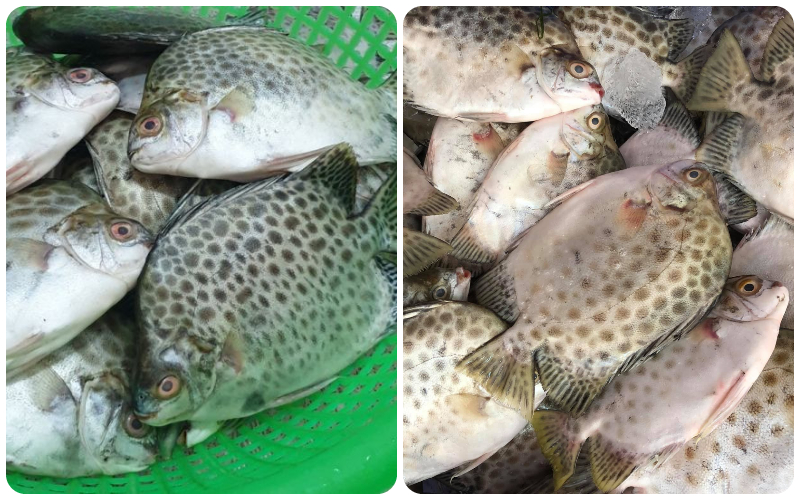 Scat fish.
Scat fish.
However, scat fish have venomous spines on their dorsal and ventral fins, so caution is advised when handling and cleaning them; wearing gloves is recommended.
Rabbitfish
This species is familiar in the provinces of Quang Nam, Quang Thai, Thua Thien Hue, and the lower regions of Thu Bon, Hieu, and Ben Hai rivers in Quang Tri. Rabbitfish, with the scientific name Siganus, are nocturnal foragers, omnivorous, and live in schools, exhibiting migratory behavior.
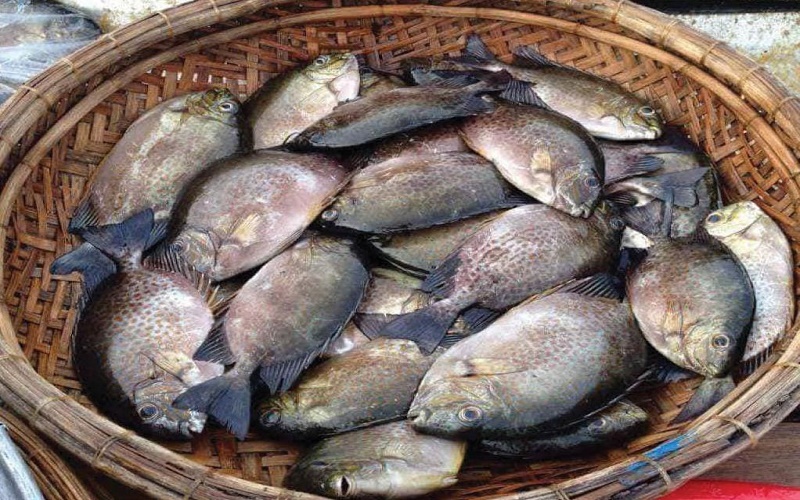 Rabbitfish are nocturnal foragers, omnivorous, and live in schools.
Rabbitfish are nocturnal foragers, omnivorous, and live in schools.
The body of the rabbitfish resembles an oval compressed on both sides, with large, round eyes and an average length of 25-30 cm, weighing 1-2 kg. Its body is smooth, with a slightly black or brownish-gray color, a silver belly with yellow spots, and a short head and mouth. The meat is sweet and tasty.
Mullet
Mullet is a species that typically inhabits temperate and tropical coastal areas, as well as brackish and saltwater environments. Belonging to the order Mugiliformes, mullet can reach lengths of 20-90 cm, with a gray or bluish back, a slightly yellow belly, two short dorsal fins, a wide and flat head, and a moderate-sized mouth with few or no teeth.
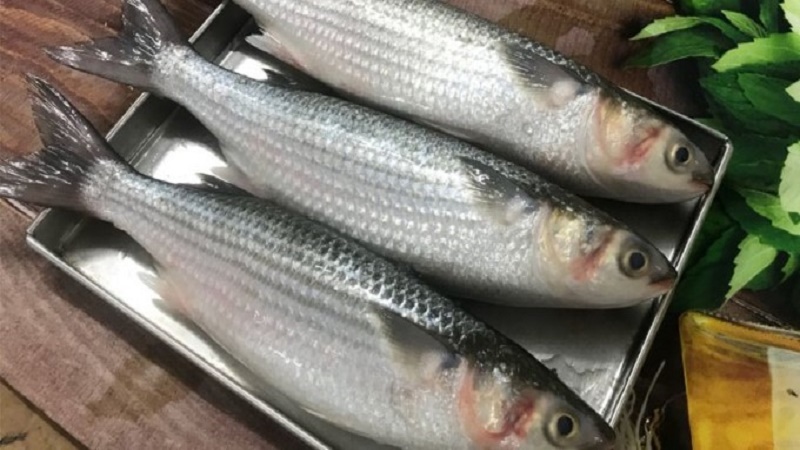 Mullet belongs to the order Mugiliformes.
Mullet belongs to the order Mugiliformes.
Mullet has many bones and scales, but its meat is fatty and nutritious, especially its delicious roe, making it a favorite among many.
Yellowtail Scad
Yellowtail scad is a species with high economic value, commonly exploited in tropical and subtropical seas such as the Indian Ocean and the Pacific Ocean. With the scientific name Scomberoides, it has many varieties, and the most commonly seen is the yellow scad, with a greenish-brown body and yellow scales.
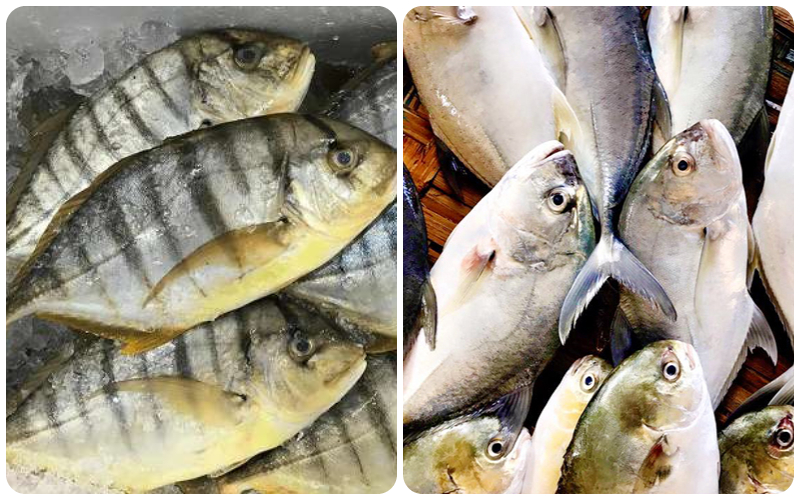 Yellowtail scad has high economic value.
Yellowtail scad has high economic value.
The body of the yellowtail scad is elongated and flattened, with a silver-white color along its back and sides, and an average weight of 0.8-2 kg. This species lives in schools, and in Vietnam, they are usually found in nearshore waters, river mouths, small bays, reefs, and offshore capes.
Golden-winged Pomfret
Golden-winged pomfret, with the scientific name Trachinotus blochii, is also called white pomfret with yellow fins and belongs to the jack family (Carangidae). In Vietnam, they are mainly farmed in brackish water ponds and coastal waters.
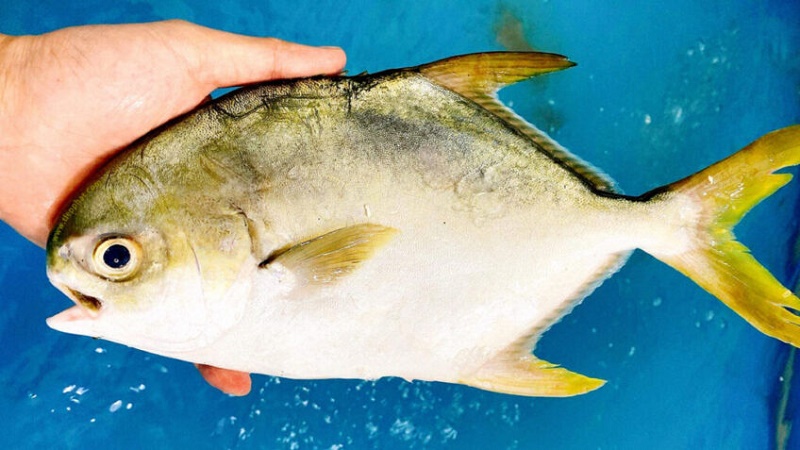 Golden-winged pomfret, with the scientific name Trachinotus blochii.
Golden-winged pomfret, with the scientific name Trachinotus blochii.
The body of the golden-winged pomfret is flat, with a silvery sheen and yellow fins. With an average weight of 600-800 grams, it is highly valued for its delicious, tender meat and relatively high price, often being exported.
Milkfish
Milkfish, with the English name milkfish and the scientific name Chanos chanos, belongs to the family Channidae and is also known as chua or măng sữa fish. This species is distributed in warm seas of the Indian and Pacific Oceans, from the Red Sea and South Africa to Hawaii, Japan, northern Australia, and even off the coast of California.
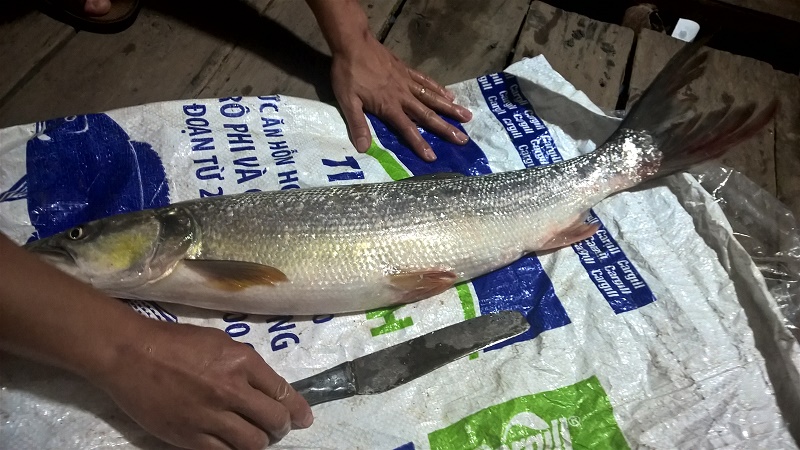 Milkfish, with the English name milkfish.
Milkfish, with the English name milkfish.
In Vietnam, milkfish are commonly found in the central coastal regions, from Nha Trang in Khanh Hoa province to Phan Thiet in Binh Thuan province, but they are most famous in Song Da. They have a long and flat body on both sides, a large, blunt, and rounded snout, and round scales. With a single dorsal fin, low pectoral fins, small pelvic fins, and a wide caudal fin, milkfish have a small mouth without teeth or barbels. Their back is greenish, their belly and flanks are white, and the edges of their caudal and dorsal fins are black.
 Milkfish have a fast growth rate.
Milkfish have a fast growth rate.
Additionally, milkfish typically weigh between 5 and 12 kg and reach lengths of 0.7 to 1.5 meters, with males growing up to 1.8 meters long and weighing 14 kg. Milkfish have a rapid growth rate, and their meat is very tasty, sweet, chewy, and reddish, making them highly nutritious. As a result, they are not only used as a daily food source but also as gifts for special occasions and holidays.
The above are the common brackish water fish species that homemakers should know to identify and buy accurately. Furthermore, we hope that this information helps readers gain a deeper understanding of brackish water fish.
Brewing up a Tasty Treat with Chéc Fish (Catla Fish)
Discover the unique flavor of sturgeon fish and learn how to craft tasty recipes with it! Beluga sturgeon is a nutritious seafood option that offers an array of stimulating flavors. This article will discuss all the aspects of sturgeon fish and provide guidance on how to prepare a delicious meal featuring it.


























